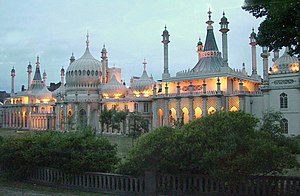History of The Seaside Holiday
Seaside Holidays are a popular topic in schools but how did seaside holidays come about. This article explains why people first went to the seaside and where their desire to go into the sea came from.
The origins of sea bathing
The English are an island race and have from the earliest times depended on the sea for both trade and defence. It was naval supremacy which enabled us to build a massive empire. Our mastery of the sea enabled us to become wealthy and powerful. The English have always been a sea faring nation.
Given the significance of the sea it would be reasonable to imagine that the English would worship the oceans and that going into the water would be as natural to them as it is for duck or an otter perhaps. Not so. In fact most of the coastline surrounding our island was virtually uninhabited for a very long time. There were the main ports and harbours which were busy thriving places. There were also many little settlements occupied by fisher folk dotted here and there. Most of the shoreline however was devoid of people.
It seems that the English had an aversion to water for although they were surrounded by it and depended on it for their security and their economy. Yet they never went in it! In fact they hardly ever washed themselves never mind actually immersing themselves in water to get clean. Even swimming in lakes and rivers was frowned upon and swimming for pleasure was thought to be immoral. There can be no doubt that people living in the sixteenth and seventeenth centuries positively ponged. Any gathering, especially if indoors must have given rise to the most awful concoction of smells which would be quite unbearable to us today.
The exception to this apparent phobia of water was the inland Spas. These were places where pure water enriched with minerals came up from the ground. Spa water was believed to have health giving properties which could cure all manner of ailments. Rich people flocked to the Spa towns in order to take advantage of benefits of the spa water. They would go into the spa bath fully clothed in many cases. One can only imagine how filthy and unhygienic the water must have been. Attendants had to be employed to regularly scrape the scum from the surface.
The spa towns were popular places with hotels, theatres, shops and entertainment of all kinds. All the best people in society visited them. They were the playground of the rich and famous.
In 1626 a lady called Mrs Farrow was walking along the sands at Scarborough when she noticed a spring of water issuing out of a cliff. The stones over which the water passed had changed colour. When she tasted the water she found it had an acidic taste. Mrs Farrow took the water and gave it to friends who were ill. The drank and felt much better. Soon all of Scarborough was drinking the water and feeling better. Word spread rapidly and soon persons of quality were travelling from all over England to partake of the famous health giving liquid. Scarborough had become a spa town.
The virtues of the Scarborough Spaw ardently promoted by a certain Dr Wittie who claimed that Mrs farrows spring could cure just about anything
” It cleanses the stomach, opens the lungs, cures asthma and scurvy, purifies the blood, cures jaunders, both yellow and black, the leprossie and moreover a most sovereign remedy against hypocondriack, melancholy and windiness “
Needless to say there were storms of protest from the other established inland spa towns. However Dr Wittie had another trump card up his sleeve – the sea! The sea cured gout, ” kills all manner of worms ” and could was also ideal for ” drying up superfluous humours and preserving from putrefaction ” He claimed that only Scarborough could provide for both internal and external purification.
It was from the discovery of a spa at Scarborough and the claims of Dr Wittie which would seem to have caused the mania for drinking sea water which followed during the eighteenth century. Physicians became obsessed with prescribing courses of sea water drinking, sometimes as much as 25 gallons to be taken at the rate of a pint a day. It didn’t seem to matter that the patient suffered from sickness and diarrhoea, thirst and nausea as a result. Drunk it must be. Sometimes it was mixed with milk to make it a little more palatable. For those who could not get to the seaside it was sold in bottles.
Although the mania gradually died some Victorian children were forced to begin their seaside holidays by gulping down a tumbler full of sea water.
Whilst drinking sea water was an internal cure the application of sea water externally was also perceived to be highly beneficial and learned doctors encouraged the taking of the cold bath as part of what became known as the cure.
A keen advocate of the cold bath was Dr Russell who sent wealthy patients to dip themselves in the sea.
” A perfect repose of the body and calmness of the mind is to be observed before the use of the bath and all the exercise of the parts affected must be forborne, that the fibres by these means , when they contract themselves ,may have the greater force to overcome any obstruction. The greatest care is to be taken to know whether the bowels are sound or not before the use of the bath…a little draught of sea water is convenient immediately upon coming up out of the sea because by purging the belly it prevents the blood from flying to the head.”
It would seem that the fashion for dipping ones self into the sea began at Scarborough and rapidly spread elsewhere. The upper crust of society made haste to the coast to experience the health giving properties of sea water.
The doctors advised that the water should be entered when it was very cold, early morning being the best time and the colder the water the better.
As most people could not swim they went for a dip often utilising bathing machines which were towed out into the waves. The sea bathing was then facilitated by a dipping lady who would assist the occupants to enter and exit the water.
This then is the origin of sea bathing.
Bring your Seaside Topic to life!
Book a Seaside Workshop Day for your seaside topic.
Related articles
 The Health Benefits of Sea Salt
The Health Benefits of Sea Salt


 The Health Benefits of Sea Salt
The Health Benefits of Sea Salt






